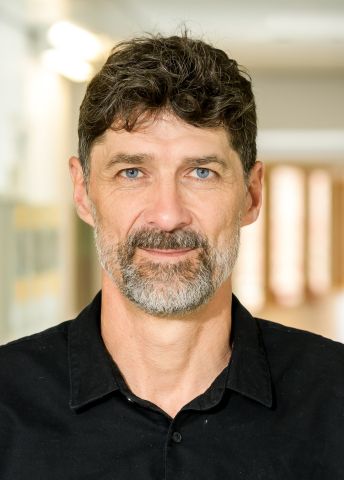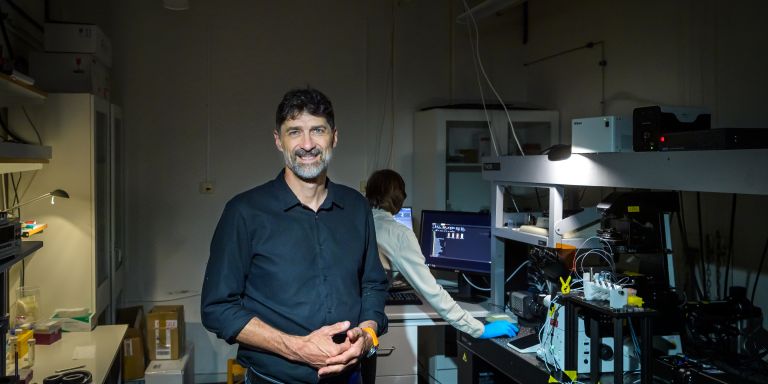
Heiner Linke
Professor of Nanophysics
Wallenberg Scholar
Institution:
Lund University
Research field:
Thermal motion for directed transport, motor proteins, nanotechnology.


Wallenberg Scholar
Institution:
Lund University
Research field:
Thermal motion for directed transport, motor proteins, nanotechnology.
Only when the temperature falls to absolute zero is everything absolutely still. Otherwise matter is constantly in motion – at atomic, molecular and electron level.
“Thermal motion is a completely ‘free’ form of motion that simply exists. I have long been interested in whether it could be put to use in some way,” says Linke, who is professor of nanophysics and Wallenberg Scholar at Lund University.
He began pondering the question when he was a PhD student, and gained inspiration when he moved to Sydney as a postdoc, where he met Paul Curmi, a structural biologist. While Linke had been working on the motion of electrons in semiconductors, Curmi had been studying motion in proteins. This shared interest was to form the basis for many years of collaboration. In February 2024 an article was published in a scientific journal called Nature Communications describing the world’s first artificial motors creating motion with the help of proteins. The motor mimics a biological phenomenon known as burnt-bridge ratchet, where a structure moves forward by removing parts of a filament, which is degraded in the process.
The researchers’ solution was a micrometer-sized ball covered in enzymes capable of splitting proteins.
“We place the substrate that the enzymes can ‘chew’ on a surface. When random thermal motion brings them into contact with the substrate they chew it to pieces and the ball moves toward it. Further thermal motion brings them into contact with more substrate and so it goes on,” Linke explains.
On a smooth surface the motor would merely have moved back and forth at random. But the researchers used nanotechnology to create a minute substrate-coated channel. This induced the ball to move in a single direction, without the addition of external energy. Artificial molecular motors have been fabricated before, but this is the first one that is based solely on proteins and that moves along a nano-made path. Numerous bodily processes use miniature “motors” to mechanically achieve various tasks, such as manufacturing DNA or proteins. The mechanics are well known, but how the energy is converted into motion is less well understood.
“It’s actually remarkable that we don’t know how they do it – given all the other things we know about proteins! It’s an energy conversion process that is quite unlike anything we use in the engines we have fabricated. I want to understand it. This is pure basic research.”
The motor protein was a ball of polymer material coated with natural enzymes. Now Linke and his colleagues want to create a new protein – a molecule that moves independently in a predetermined direction. This is what some of the body’s motor proteins do. Myosin, which causes muscles to contract, is one example. As a Wallenberg Scholar, Linke also wants to gather expertise to create a new research environment in Lund: nanotechnology aided by protein design.
“Proteins are obviously a highly capable material, but we have barely begun to ask ourselves what we can create with them outside the field of biology. It’s a kind of nanotechnology that we haven’t started to use yet.”
We don’t even have the right words to describe how proteins convert energy into motion. That’s usually a sign that we don’t understand the phenomenon.
His vision is that researchers in Lund can use their knowledge of biotechnology, molecular biology and nanotechnology in combination with AI to fabricate completely new materials with new properties.
“When we began to design artificial motor proteins fifteen years ago it would have been crazy to even try. But things are different now. It’s still an ambitious goal, but a more feasible one.”
Linke grew up in Germany and studied for his undergraduate degree in Munich. He chose Lund in Sweden as the base for work on his thesis, and it was there that he met his partner. Together they moved to Australia, followed by Oregon in the US, before returning to Lund. But it took many years before Linke decided definitely to remain in the academic world.
“I began studying physics because it was the only subject I was really good at in school. I originally planned to join the commercial sector after that, but the idea of doing a PhD appealed to me. After that I realized that a postdoc position would allow me to move to yet another new country…”
He had no long-term goal, but a clear short-term one: he wanted to continue if his research yielded results and he found it enjoyable. Both criteria were met.
Since he returned to Lund he has been head of division, director of the NanoLund strategic research area and deputy dean at Lund University’s Faculty of Engineering (LTH).
“The managerial roles have been very rewarding, but after three years as deputy dean I decided to stand down. I wanted to return to full-time research.”
At that time he had been in receipt of a large multi-year research grant from the European Research Council, and felt that he wanted to better focus on the project and his research team. And it was around then that he was chosen as a Wallenberg Scholar.
“The best thing about my job is that I’m surrounded by gifted people driven by curiosity. My fellow researchers, PhD students and postdocs possess the wide range of skills needed to bring my ideas to fruition. I myself have many limitations – I have virtually no laboratory skills, and those I possess are outdated. But when I have an idea I know exactly who I should turn to. It’s a great feeling.”
Text Lisa Kirsebom
Translation Maxwell Arding
Photo Kennet Ruona